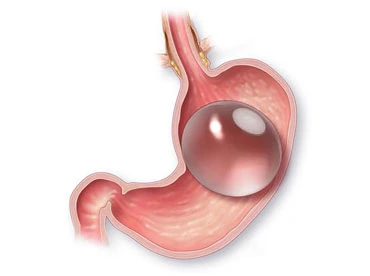
Desire to look younger? A Facelift is your best option
What is a Gastric Balloon?
A deflated silicone balloon is put into your stomach and then filled with saline solution. This treatment is considered to be minimally invasive. Its purpose is to reduce the amount of food that your stomach is able to contain and to assist you in feeling fuller more quickly.
The gastric balloon, which is also referred to as an intragastric balloon, is a weight loss method that does not include surgery and is aimed to assist individuals in losing weight by occupying space in the stomach. This subsequently reduces the quantity of food that the stomach is able to process.
In the following sections, we will provide a comprehensive summary of the outcomes and effectiveness of the gastric balloon procedure:

Recovery and Procedure for Gastric Balloon
After being endoscopically inserted into the stomach, the gastric balloon—also referred to as the intragastric balloon—is filled with saline. Under sedation, the process often takes 20 to 30 minutes. Moreover, the process is divided into two stages: insertion and removal in the months that follow.
Most patients are able to return home that day. Patients are encouraged to follow a liquid diet for a few days during this period of adjustment before progressively introducing solid foods.
Enjoy The Benefits of Gastric Balloon
Better metabolic health: Losing weight with the gastric balloon can help with health problems like type 2 diabetes, high blood pressure, and cholesterol.
Better Mobility: Many people say that losing weight has helped them move around better and lessened joint pain.
BMI Reduction: Most patients notice a decrease in their BMI. The average BMI reduction is 5-10 points.
Short-term: Most people lose between 10 and 15 percent of their body weight in the first six months.
Long-term: The ability to maintain weight loss varies. According to studies, patients may recover some weight after the balloon is removed, but continuing to make lifestyle adjustments can help them lose weight.
Reach your ideal weight with the Gastric Balloon: the non-invasive solution that helps you lose weight quickly and safely. Start your transformation today and discover a new version of you!
Eligibility And Age for Gastric Balloon
Eligibility for the gastric balloon procedure may vary depending on specific medical guidelines and local regulations, but generally includes the following criteria:
Body Mass Index (BMI): Usually recommended for people with a BMI of 30 to 40, although some clinics may offer it to people with a BMI greater than 27 if they have medical conditions related to obesity.
Age: Generally, it is recommended for people between 18 and 65 years old. Some centers may consider patients outside this age range on a case-by-case basis.
Previous Weight Loss Attempts: The procedure is usually indicated for people who have attempted to lose weight through diet and exercise without significant success.
Commitment to the Program: It is essential that the patient be willing to follow a supervised program of diet, exercise, and medical consultations during and after the procedure.
Medical Conditions: There should be no medical conditions that contraindicate the use of the gastric balloon, such as serious gastric or esophageal problems, previous surgeries in the stomach, or certain inflammatory diseases.
It is important to consult with a healthcare professional to evaluate each patient’s specific eligibility and receive appropriate guidance regarding the procedure.
Procedure Steps
STEP 1: BEFORE SURGERY
- Medical evaluation, including a physical exam, medical history review, and necessary tests (e.g., blood tests, ECG).
- Discussion of the procedure, risks, benefits, and expected outcomes.
- Follow a special diet for a few days before the procedure to prepare the stomach, often a liquid or low-residue diet.
- Fasting for 12 hours before the procedure.
STEP 2: SURGERY DATE
- Arrive at the clinic or hospital as scheduled.
- Complete any remaining paperwork and pre-procedure checks.
- An IV line is placed for administering medications.
- The procedure is typically performed under light sedation or anesthesia.
- The entire procedure usually takes about 20-30 minutes.
STEP 3: AFTER SURGERY
- Monitor in a recovery area until the effects of sedation wear off.
- Most patients can go home the same day.
- Follow a specific post-procedure diet, starting with clear liquids and gradually progressing to soft foods and then a regular diet over a few weeks.
- Stay hydrated and avoid alcohol and caffeine initially.
- Take prescribed medications to reduce stomach acid and prevent nausea or discomfort.
STEP 4: BALLON REMOVAL
- The balloon is typically left in place for six months, after which it is removed in a similar endoscopic procedure.
- Follow the same pre-procedure steps for balloon removal, including fasting and possible medication adjustments.
Frequently Asked Questions
WHO IS A CANDIDATE FOR THE GASTRIC BALLOON PROCEDURE?
Candidates typically have a BMI of 30-40 and have not been successful with diet and exercise alone. A healthcare provider will evaluate individual eligibility.
IS THE GASTRIC BALLOON PROCEDURE SAFE?
Yes, it is generally safe, but like any medical procedure, it carries some risks, such as nausea, vomiting, and in rare cases, balloon deflation or migration.
HOW MUCH WEIGHT CAN I EXPECT TO LOSE WITH A GASTRIC BALLOON?
Patients typically lose between 10% to 15% of their total body weight within six months of the procedure.
HOW LONG DOES THE GASTRIC BALLOON STAY IN THE STOMACH?
The balloon is designed to remain in the stomach for six to eight months. This length of stay is determined by the weight before and the amount of weight to be lost. After this period, it is removed by endoscopy.
WILL I NEED TO FOLLOW A SPECIAL DIET WITH THE GASTRIC BALLOON?
Yes, patients will need to follow a specific diet plan provided by their healthcare team to ensure the best results and minimize side effects.
CAN I FINANCE MY GASTRIC BALLOON PROCEDURE?
Yes, you can visit our Financing options page where we list the different financing platforms that we usually use.
ARE THERE ANY SIDE EFFECTS OR COMPLICATIONS ASSOCIATED WITH THE GASTRIC BALLOON?
Common side effects include nausea, vomiting, and abdominal discomfort. These symptoms usually subside within a few days. Serious complications are rare but can include balloon deflation, migration, or obstruction.





